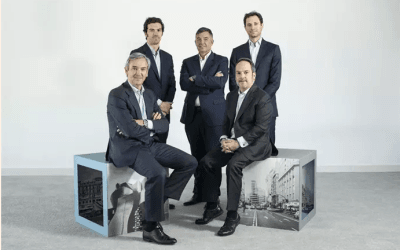Aurica Bets on Technology and Services Companies
Aurica is focusing on technology and services companies given that the firm operates as a growth and expansion fund, where transactions are carried out without financial leverage. Aurica’s goal is to generate attractive returns for investors, and instead of relying on deleveraging, it focuses on companies operating in tailwind sectors with scalable business models, so they can significantly increase their size within 3–5 years.
This clear focus on service companies is based on the fact that the firm has identified greater opportunities to achieve relevant growth without requiring large-scale investments, unlike industrial companies, which must undertake heavy capital expenditures in factories or similar assets.
By expanding its scope within services and technology companies, Aurica is currently concentrating on the following verticals:
- Digitalization and Technology: primarily focused on service companies driving digital transformation, such as former portfolio companies Babel (IT consulting) and Samy Alliance (influencer marketing), as well as current holdings including t2ó one (digital marketing), Alquiler Seguro (proptech), and Educa Edtech (online education).
- Health and Wellness: focused on service companies aligned with trends in senior care, personal well-being, and sports. Aurica considers these sectors to be defensive in a downturn and notes that Spain holds international leadership in these areas. Current holdings include Canitas (veterinary clinics), with expectations to increase exposure to these segments in the coming years.
- Business Services: diverse B2B services with different growth drivers, including defense and aerospace, financial and legal services, as well as environmental services supporting the energy transition — exemplified by the successful exit of STI Norland (solar trackers).
As a fund with a strong focus on growth, Aurica pays particular attention to this variable and currently considers three main growth strategies, depending on each company’s circumstances:
- Organic Growth: targeting companies achieving annual growth above 20%. The strategy seeks to replicate the business model in new geographies while maintaining strong growth in existing markets.
- Buy & Build: combining organic growth (10–20% annually) with inorganic growth to enhance value propositions, expand geographic reach, or diversify client types. Through inorganic growth, Aurica helps companies achieve an additional growth layer beyond their organic potential.
- Perimeter Expansion: replicating a proven concept through new installed capacity, applicable to businesses such as veterinary clinics, restaurants, or agriculture.
This sector and company profile analysis applies to both the U.S. and Spain, which are Aurica’s current core regions of focus.
United States Accelerates, Europe Reorganizes, Spain Fits In – Aurica Capital’s Research Team
After more than a decade of cheap money and smoothly running global supply chains, the world is facing what appears to be a regime shift. A harsher geopolitical climate, trade route tensions, and new technologies promising productivity gains—while also creating new pressures around energy, data, and regulation—are reshaping the landscape. In this crossroads, the United States is stepping on the industrial accelerator, Europe is reshuffling priorities, and Spain is quietly fitting several pieces together, leaving it in a stronger position than a decade ago.
The old world was defined by three forces: globalization, low interest rates, and cheap energy. The road ahead is more complex. Wars in Europe and the Middle East have highlighted that trade depends on vulnerable routes. The U.S., in what once seemed counterintuitive for the homeland of laissez-faire, has pivoted politically toward protectionism, choosing to bring manufacturing back home—chips, batteries, electrical components—while securing its energy and digital backbone. The practical result is not a collapse of trade, but rather a regional reconfiguration: less “just-in-time” efficiency, more “just-in-case” resilience, and therefore higher costs.
Artificial intelligence adds another variable. Its potential to boost productivity is hard to ignore, from automated factories to professional services scaling with software. Yet, investors must keep two warnings in mind. First, benefits lag behind heavy investments in compute, talent, and data. Second, bubbles rarely arise from useless technologies but from disordered expectations. Against this backdrop, the U.S. offers strong industrial momentum, attracting advanced manufacturing projects and turning reshoring rhetoric into reality.
Innovation remains a cornerstone of the U.S. economy. The density of talent and capital in its tech hubs creates a virtuous cycle where Big Tech, universities, and venture capital feed advances that diffuse into the wider economy—an inertia not easily replicated elsewhere.
Europe, by contrast, is taking a different path. Several governments have begun to openly acknowledge what demographers have long repeated: the social model demands higher productivity per hour worked and stronger growth potential in an aging continent. Far from being bad news, this honesty helps focus capital on what truly matters. In uncertain times, investing in certainties makes sense: an aging population demanding healthcare and personal care; a services-based economy dominated by SMEs; an irreversible commitment to decarbonization and energy independence; and digitalization, now a requirement for competitiveness rather than a passing trend. Europe’s fragmented markets also offer a distinctive feature: disciplined operations and orderly consolidation create value independently of the business cycle.
In this map, Spain has significantly improved its relative position. Its leadership in renewables, regasification capacity, and one of Europe’s best fiber optic networks have lowered and stabilized key inputs for energy-intensive industries and digital services. Spain has outpaced eurozone average growth and offers abundant opportunities in structurally growing sectors. The investor’s challenge lies in the details: robust governance and compliance to navigate new protectionism, supply chain traceability, pricing power, and operational integration that creates real value—not just size.
We cannot choose the world we invest in, but we can choose how we invest. Today’s temptation is to debate whether AI is the new electricity or the next bubble, whether protectionism is temporary or structural, or when current wars might end. While interesting, such debates alone don’t generate sustainable returns. The investor’s agenda must focus on companies that can become essential in this new context—one where the U.S. leads the industrial push, Europe reorganizes priorities, and Spain, for the first time in a long while, fits in with its own unique strengths.
Entradas recientes
- Aurica Bets on Technology and Services Companies
- Aurica Capital sells 100% of its stake in Samy Road to Bridgepoint
- Aurica partners with A&G Global Investors to drive SME investment in the United States
- Aurica Capital achieves the highest rating in UN PRI 2024
- Aurica Capital sells 100% of its stake in Babel to Mubadala


